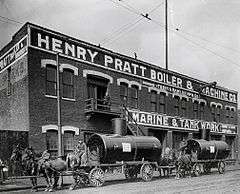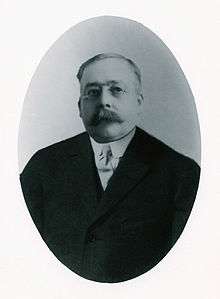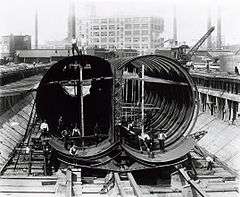Henry Pratt Co
 | |
| Industry | Energy and Water |
|---|---|
| Headquarters | Aurora, Illinois, United States |
Area served | North America |
| Website |
www |
Henry Pratt Company, located in Aurora, Illinois, is one of North America’s largest manufacturers of valves for the potable water, wastewater, power generation and industrial markets.[1] The Henry Pratt Company is a subsidiary of Mueller Water Products, Inc., a NYSE publicly traded company headquartered in Atlanta, Georgia.
History
| Henry Pratt Boiler & Machine | |
|---|---|
 The Henry Pratt Boiler & Machine Co at 875 S. Halsted St. in Chicago, circa 1903 |
The history of the Henry Pratt Company is closely connected with the history of early 20th century Chicago, Illinois, as the company was involved with many of the city’s earliest infrastructure projects.
As far back as 1888, a Pratt advertisement ran in the September 20 issue of Light, Heat & Power magazine, a periodical published by the Louisville Gas & Electric Company. The ad for Henry Pratt and Company featured water gas generators, condensers, scrubbers, and purifiers, all of which were used in the coal and water gas markets. Henry Pratt, the company’s founder, was an engineer who held numerous patents for the apparatus required in the manufacture of water gas. Water gas is a synthesis gas used from the 1870s to the early 1900s as a source of heat and light in residences and factories.[2] Pratt worked with fabricators in Chicago to produce the high quality equipment needed in the municipal gasification plants.
| Henry Pratt | |
|---|---|
 Henry Pratt, engineer and founder of Henry Pratt Boiler & Machine Co |
The Henry Pratt Boiler and Machine Company was incorporated in the State of Illinois on November 1, 1901, with Henry Pratt named as President and Treasurer. It was located at 875 S. Halsted Street in Chicago in a building that housed the office, machine shop and boiler shop. The Henry Pratt Boiler and Machine Company provided 16” valves for the first electric generating station of any significant size in the city of Chicago, which was built by Commonwealth Edison at Fisk Street in 1903.[3][4]
| LaSalle St. Tunnel Construction | |
|---|---|
 Beginning the assembly of steel tube for the LaSalle Street Tunnel |
When the reversing of the Chicago River exposed the LaSalle Street cable car tunnel[5] in 1900, a wider and deeper replacement tunnel was proposed and designed. The Henry Pratt Company fabricated and installed the steel plate tunnel that ran under the Chicago River and opened to streetcar service in 1912.
| LaSalle St. Tunnel Construction | |
|---|---|
 Assembly of steel tube for river section of LaSalle Street Tunnel |
In 1909, the company moved to 2222 S. Halsted Street and its name changed to the Henry Pratt Company. Henry Pratt, the engineer for whom the company was named, died in December 1914, but because of his excellent reputation, the company retained his name.
During World War I, the Henry Pratt Company manufactured propellers for Liberty Ships (the Hog Islander ships[6]) and in the 1920s, the company manufactured products for electric power plants and gas plants.
The Henry Pratt Company has a tradition of industry firsts. When welding came into use in the mid 1920s, Pratt was instrumental in the design and production of the first welded smoke stack,[7] which was installed at Commonwealth Edison’s Fisk Street Generating Station.
| LaSalle St. Tunnel Construction | |
|---|---|
 November 15, 1910 LaSalle Street Tunnel - Steel tube for river section - bulkhead in place preparatory to floating out of dry dock |
Another innovation for the Henry Pratt Company was the design of the first rubber-seated butterfly valve. Pratt applied for the patent in 1930 and it was granted in 1934.[8] These original rubber-seated butterfly valves were created for “controlling the flow of air, powdered coal, ash water, etc., under low pressures.”
At the height of the Depression, Pratt became a prime mechanical contractor for the Century of Progress Exposition, the 1933 World’s Fair held in Chicago. Some of the projects that Pratt manufactured for the fair included:
- A cover for the Black Forest Ice Rink, which rolled out to become a dance floor.
- A Wonder Baker’s display
- Angle iron platform for the U.S. Steel Bessemer converter
Henry Pratt Company then designed a 30” water butterfly valve for Duquesne Light & Power in Pittsburgh, Pennsylvania, after which Pratt targeted other utility companies and the waterworks industry. The American Water Works Association issued a specification for the butterfly valve, AWWA C-504, in 1954. In 1956 Henry Pratt Company manufactured butterfly valves for the world’s largest capacity water filtration plant, the Central District Filtration Plant (now known as the Jardine Water Purification Plant) that was built next to Navy Pier, in Chicago, Illinois.
During World War II, the Henry Pratt Company received an order to produce nickel-plating machines under the highest material priority rating, a system used to designate projects that were vital to the war effort. The company also provided 16” butterfly valves for the Manhattan Project and received a certificate of excellence from the United States Atomic Energy Commission for their work.
In the late 1940s, when sales of butterfly valves began to grow, an additional plant was purchased for the manufacture of valves. The plant, located at 900 Depot Avenue in Dixon, Illinois, was composed of buildings dating back to the Civil War. After the Civil War, the buildings housed the Grand Detour Plow Works, which was a forerunner of the John Deere Company. This plant was closed in 2007.
There was a great demand for valves of all types in the decades following World War II, as the construction industry boomed and corresponding municipal projects grew. As a result, Henry Pratt Co added ball valves, check valves and various types of butterfly valves[9][10][11] to their product line, in order to meet the demands of America’s expanding infrastructure.
By 1965, small valve production was moved to a plant at 401 South Highland Avenue in Aurora, Illinois, where corporate offices were also re-located.
From 1901 to 1958, Henry Pratt Company was a closely held company, owned by active employees. In 1978, Amsted Industries, headquartered in Chicago, Illinois purchased Pratt. After managers and outside investors purchased Pratt from Amsted in 1989, Watts Industries Inc., of Boston, MA, purchased Henry Pratt Company in 1991.
On September 4, 1996, Tyco International Ltd. of Exeter, New Hampshire purchased the Henry Pratt Company and then transferred ownership in 1999 to a private investment group headed by Credit Suisse. From 1999 to 2003, Pratt acquired the Ardillo Corporation, assets of Lindsey Fabricators, Inc., Virginia Valve, CCNE, Inc., Hydro Gate Corporation, Milliken Valve Company and Jingmen Pratt Valve, Co., Ltd. The Henry Pratt Company is a subsidiary of the Mueller Water Products Company.
Henry Pratt Co added plunger valves to their product line in 2011, and air valves in 2012.
The tradition of heavy investment in research and development continues at the Henry Pratt Company. As a result, Pratt holds numerous patents, and the list of industry firsts for the company is long:
- Rubber-seat butterfly valve
- Rubber-seat ball valve
- High-pressure rubber-seat ball valves for water distribution service
- Development of the replaceable seat concept for large diameter butterfly valves
- Perfection of the “molded-in” seat concept for smaller butterfly valves
- Rubber-seat butterfly valve for circulating water systems in water plants
- Condenser partition rubber-seat butterfly valve
- Combination expansion joint/flangeless valve
- 150 psi service water valve
- Rectangular and obround shaped rubber-seat butterfly valve
- Fast closing valve to shut off ventilating systems in nuclear power plants
- Non-metallic power cylinder for valve operators
 U.S. Patent documents issued October 16, 1934 to Henry Pratt for Rubber Seat Butterfly Valve Page 1
U.S. Patent documents issued October 16, 1934 to Henry Pratt for Rubber Seat Butterfly Valve Page 1 U.S. Patent documents issued October 16, 1934 to Henry Pratt for Rubber Seat Butterfly Valve Page 2
U.S. Patent documents issued October 16, 1934 to Henry Pratt for Rubber Seat Butterfly Valve Page 2 Drawing disclosure of U.S. Patent issued to Henry Pratt for Rubber Seat Butterfly Valve Page 1
Drawing disclosure of U.S. Patent issued to Henry Pratt for Rubber Seat Butterfly Valve Page 1 Drawing disclosure of U.S. Patent issued to Henry Pratt for Rubber Seat Butterfly Valve Page 2
Drawing disclosure of U.S. Patent issued to Henry Pratt for Rubber Seat Butterfly Valve Page 2
Company Products
- Air Valves
- Butterfly Valves
- Ball Valves
- Check Valves
- Plug Valves
- Cone Valves
- Energy Dissipating Valves
- Rectangular Valves
- Industrial Valves
- Fire Protection Products
- Nuclear Valves
- Actuators
- Control Systems
- Accessories
References
- ↑ Henry Pratt Company, LLC. Company Description Hoovers. Retrieved 2014-01-10
- ↑ Gasifipedia: Water Gas Shift. The National Energy Technology Laboratory, (DOE) (NETL), the Energy Lab, Water Gas Shift
- ↑ Emergence of electrical utilities in America. Fisk Street Station, National Museum of American History, Kenneth of Behring Center.
- ↑ Chicago's Fisk Street Station, The Insulator Gazette, Saturday, May 16, 1908.
- ↑ LaSalle Street Tunnel, The Great Chicago Fire & Web of Memory
- ↑ Hog Islanders, American Merchant Marine at War
- ↑ Welded Smokestacks, General Welding Practice, Fred E. Rogers Acetylene Journal, January 1922
- ↑ United States Patent and Trademark Office. Patent 1,977,351, November 26, 1930.
- ↑ October 2004, "Thinking Outside the Box," Water & Waste Digest
- ↑ Trude Witham, July/August 2012, "Buying into the Vision," Water System Operator
- ↑ Jim Force, May 2012, "Leading a Town to Water," Municipal Sewer and Water
External links
- Fisk Street
- LaSalle Street
- Hog Islanders
- Butterfly Valves
- Jardine Water Purification Plant
- Grand Detour Plow Works
- Hydro Gate Corporation
- Milliken Valve Company